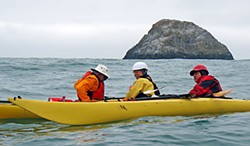[
{
"name": "Top Stories Video Pair",
"insertPoint": "7",
"component": "17087298",
"parentWrapperClass": "fdn-ads-inline-content-block",
"requiredCountToDisplay": "1"
}
]
Pilot Rock is the outermost of Trinidad Bay's scattering of sea stacks, located half a mile south of the tip of Trinidad Head. Half an hour of hearty paddling will get you there from Trinidad beach. Depending on the sources I found online, the top of the rock is either 93 feet or 103 feet above mean water line. It certainly looked enormous recently, as some of us kayakers enjoyed playing in the heaving sea next to the rock. "People pay to ride on roller-coasters when they can get this for free?" someone asked.
We had it easy. According to the late Axel Lindgren, a columnist for the Trinidad News & Views (as reported by Heidi Walters in the Journal four years ago), Pilot Rock "presented a daring challenge to male Indians of Tsurai [Trinidad's original Yurok name] on which to test their strength, courage and bravery against nature." After months of preparation, they would swim to Pilot Rock, spend the night there and swim home the next morning.
As I swayed in the gentle ocean swells, it was hard to imagine that a wave could overtop Pilot Rock. But that's what happened on Dec. 31, 1914, as reported by a particularly credible source: the local lighthouse keeper. The lighthouse you see now, at the end of Trinity Street, is a replica of the one built in 1871 on Trinity Head. You can still visit the remains of the original, sited nearly 200 feet above sea level, when the Coast Guard permits.
Fred Harrington was the keeper on duty during a ferocious end-of-the-year gale. In his words, "The storm commenced on Dec. 28, 1914 ... at 3 p.m. on the 31st [it] seemed to have reached its height, when it washed a number of times over Pilot Rock...
"...at 4:40 p.m., I was in the tower and had just set the lens in operation and turned to wipe the lantern room windows when I observed a sea of unusual height ... The sea itself fell over onto the top of the bluff and struck the tower on about a level with the balcony, making a terrible jar ... the tower was shivering from the impact for several seconds."
Sitting there last month in the shadow of Pilot Rock, happily rolling in 10 ft. swells, I shivered at the thought of a wave crashing over the top of the 100 ft. (more or less) rock, then slamming into the lighthouse another 100 ft. higher!
At which point, the idea of heading back to the beach looked really appealing.
It takes Barry Evans just seven minutes to be kayaking on Humboldt Bay from his home in Old Town Eureka.
CAPTION: Pilot Rock is the backdrop as Explore North Coast kayak club members David Moore, Larry Buwalda and Mark Lufkin practice rescue techniques near Trinidad. (Author photo)
more from the author
-
The Other Evolutionist
- Jul 25, 2024
-
Rise and Fall of the "Sunshine Vitamin," Part Two
- Jul 11, 2024
-
Rise and Fall of the 'Sunshine Vitamin,' Part One
- Jul 4, 2024
- More »

































